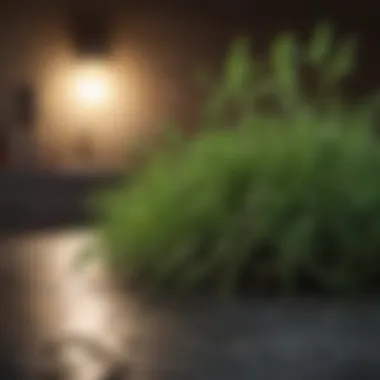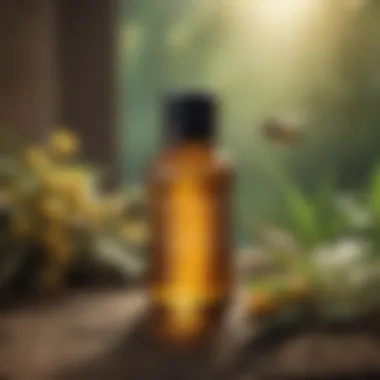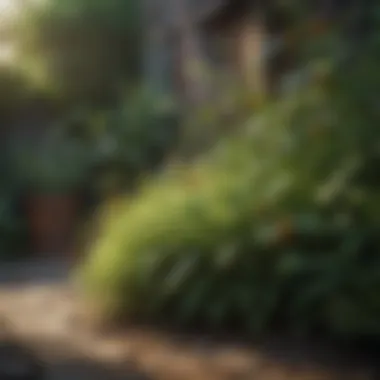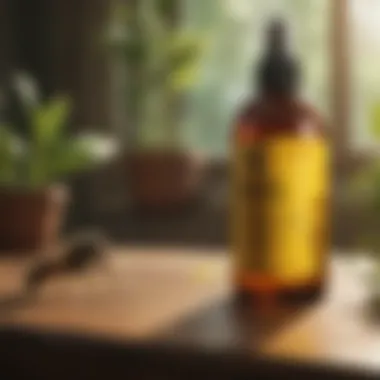Effective Scents That Repel Wasps: A Comprehensive Guide


Intro
Wasps can be a nuisance. Unlike bees, their presence can evoke anxiety in social settings such as picnics or backyard gatherings. Understanding what attracts these insects can empower homeowners to take action. One effective strategy is to explore commonly known scents that repel wasps. This article will delve into the biology of wasps and how various scents influence them. We will also look at practical methods for creating natural repellents, along with insights suitable for gardening and landscaping. By the end, readers will have a comprehensive toolkit for managing wasps effectively, ensuring a more enjoyable outdoor experience.
Understanding Wasp Behavior
To effectively repel wasps, it is crucial to understand their biology and behavior. Wasps are attracted to sweet scents and food sources. They use their keen olfactory senses to locate these areas. Certain aromas can trigger a flight response, making it essential to know which ones can be beneficial.
The Role of Scents
Wasps communicate and navigate largely through scents. When they encounter a scent they dislike, they are more likely to leave the area. Some common scents identified as deterrents include:
- Peppermint: Strong and minty, peppermint oil can deter wasps effectively.
- Cinnamon: The scent of cinnamon can be off-putting, making it less appealing for wasps.
- Vinegar: The sharp smell of vinegar can confuse these insects.
Evidence-Based Approach
Research in entomology supports the notion that certain scents decrease wasp presence. For instance, studies indicate that peppermint oil can lower wasp activity significantly due to its strong aroma.
Practical Applications
Armed with knowledge, homeowners can implement practical strategies to repel wasps. Here are several methods to create natural repellents using the identified scents:
- Peppermint Oil Spray: Combine water and a few drops of peppermint oil in a spray bottle. Target areas around your gathering space.
- Cinnamon Dust: Sprinkle ground cinnamon around entry points. This simple method acts like a barrier.
- Vinegar Trap: Fill a bowl with vinegar and a few drops of dish soap. The vinegar scent attracts the wasps while the soap traps them.
Integrating Scents into Landscaping
For those interested in gardening, incorporating plants with strong aromas can serve dual purposes: enhancing outdoor aesthetics and repelling wasps. Consider planting:
- Mint: Easy to grow and aromatic.
- Lavender: Attractive to humans but offputing for wasps.
"Integrating the right scents not only beautifies your space but also protects it from unwanted pests."
End
Understanding the scents that repel wasps opens new avenues for managing these insects. By utilizing natural repellents, homeowners can create a serene outdoor environment. This approach, grounded in science, offers practical solutions that are both effective and environmentally friendly. With this knowledge in hand, enjoy gatherings without the unwanted presence of wasps.
Understanding Wasp Behavior
Understanding the behavior of wasps is crucial for developing effective repellent strategies. Wasps are not randomly aggressive. They have specific triggers and instincts that can be influenced by their environment. When homeowners are aware of these behaviors, they can adopt more effective measures to manage their interaction with wasps and reduce stings.
The Role of Olfactory Cues
Olfactory cues play a significant role in how wasps navigate their surroundings. They rely heavily on their sense of smell to find food, mates, and nesting sites. Different scents signal various things to them, which can influence their behavior. Within the context of wasp repulsion, certain odors have been found to deter them effectively. For instance, strong floral or herbal scents can mask the pheromones that attract wasps, thus making an area less appealing. Scientific studies suggest that wasps perceive these smells in conjunction with their predatory instincts, allowing us to strategically use this knowledge.
The understanding of olfactory cues opens up avenues for natural deterrents that can be integrated into home environments. Emphasizing this behavior pattern can help in crafting preventative measures that ensure both safety and comfort in outdoor spaces.
Types of Wasps and Their Habits
Not all wasps share the same behavior patterns. Broadly speaking, wasps can be divided into two main categories: solitary wasps and social wasps. Social wasps, like yellow jackets and hornets, tend to live in colonies and can exhibit more aggressive behaviors, especially when they feel threatened. On the other hand, solitary wasps are less likely to attack humans unless provoked.
- Yellow Jackets: Known for their aggressive nature and tendency to scavenge for food. They are attracted to sweet scents and can easily become a nuisance during outdoor activities.
- Paper Wasps: More docile than yellow jackets and are recognized by their umbrella-shaped nests. They typically prefer to focus on hunting insects rather than seeking human food.
- Hornets: A subset of social wasps that can be highly territorial. Their nests are often found in trees or high structures, making them harder to avoid.
Understanding these distinctions not only helps in recognizing the kind of wasp you might encounter but also in using scent-based strategies to deter them effectively. For instance, knowing that yellow jackets are attracted to a wider range of food scents can lead homeowners to take preventive measures, especially during picnics or outdoor gatherings.


The Science Behind Scents
Understanding the science of scents is crucial in unraveling how they interact with wasps. Scents are not just pleasant or unpleasant odors; they are complex chemical compounds that can influence behavior and biology. In the context of wasps, specific scents can repel or attract them, playing a significant role in pest management. By grasping the underlying chemical principles, homeowners and gardening enthusiasts can make informed decisions about using scents to their advantage.
Chemical Composition of Scents
Each scent consists of a unique combination of volatile organic compounds (VOCs). These compounds are released into the air and can be detected by the olfactory systems of insects, including wasps. For instance, essential oils such as peppermint contain compounds like menthol and pulegone, known for their strong aroma. Similarly, lavender contains linalool and linalyl acetate, which contribute to its floral scent.
The effectiveness of a scent in repelling wasps often relies on its potency and composition. A higher concentration of VOCs typically means a stronger scent, which could better mask attractive odors or create an aversive environment for wasps.
To illustrate, when you apply peppermint oil or lavender oil in your garden, the distinctive scents may overpower the naturally sweet aromas that draw wasps in, therefore helping to deter them. Homeowners should consider the specific VOCs present in any scent they choose to utilize, as certain compounds may be more effective than others in wasp repulsion.
Effect of Scents on Insect Brain Function
Insects, including wasps, rely heavily on their sense of smell for navigation and foraging. Scents trigger responses in their brain, influencing behavior. Studies show that certain volatile compounds can induce avoidance behaviors in wasps, leading them to steer clear of treated areas.
The brain of a wasp processes olfactory signals through specialized receptors. These receptors are sensitive to specific chemical structures of scents. When a wasp encounters a scent, the olfactory signals activate neural pathways which can influence their feeding habits, mating behavior, and territorial recognition.
Furthermore, a repelling scent can disrupt these pathways. This results in confusion, causing the wasp to leave the area instead of searching for food sources. The biological reaction to scents is a powerful tool to deter wasps. Homeowners interested in natural pest management should leverage this understanding by employing strong-scented plants and oils to create an unwelcoming environment for wasps in their gardens.
Key Scents That Repel Wasps
Understanding the key scents that repel wasps is crucial for homeowners, gardeners, and anyone looking to create a wasp-free environment. Wasps are often drawn to food scents, making it essential to use fragrances that deter them. Natural scents not only keep wasps at bay but also enhance the overall aroma of outdoor spaces. Additionally, these scents can be more environmentally friendly, providing a safer alternative to chemical pesticides. Exploring various scents reveals specific characteristics, benefits, and methods for application.
Lavender
Lavender is well-known for its calming effects and pleasant fragrance. Its volatile compounds play a significant role in repelling wasps. The scent of lavender disrupts the foraging behavior of wasps, making it less likely for them to venture into areas where it is present. To utilize lavender effectively, consider planting lavender in your garden. Its vibrant purple flowers add beauty while providing practical benefits.
Peppermint
Peppermint is another potent repellent due to its strong aroma. The scent confuses wasps, leading them to avoid areas where peppermint is prominent. Additionally, peppermint oil can be diluted and sprayed in problem areas around your home and garden. Using peppermint not only helps in wasp control but also leaves a refreshing fragrance that can uplift the atmosphere of any outdoor gathering.
Cinnamon
Cinnamon might be less obvious as a wasp deterrent, but it is effective. The smell of cinnamon is often unappealing to wasps, making it a useful tool. You can use ground cinnamon or cinnamon oil to create powders or sprays that can be applied in potential wasp hotspots. The warming scent of cinnamon also provides a cozy feel, especially during cooler seasons.
Vinegar
Vinegar is well-known for its versatility in the kitchen and its ability to repel wasps. The strong acidic scent of vinegar can effectively drive wasps away. For practical application, mix equal parts water and vinegar in a spray bottle and apply it in areas where wasps are likely to gather. Keep in mind that vinegar can also attract some insects, so use this method judiciously.
Eucalyptus
The aroma of eucalyptus is refreshing, but it serves an additional purpose as a wasp repellent. The compounds found in eucalyptus oil interfere with the wasps' sense of smell, causing them to stay away from treated areas. Planting eucalyptus trees or using eucalyptus oils in sprays can provide ongoing protection against wasps, while also adding an aromatic touch to your landscape.
Clove Oil
Clove oil is another effective deterrent, prized for its strong scent. This essential oil can be particularly useful when diluted and applied as a repellent. The scent of clove oil is not only disliked by wasps but can also be soothing to humans. Incorporating clove oil into your pest control strategy can provide both effectiveness and a pleasant aroma, creating a more inviting outdoor environment.
Certain scents possess unique properties that can effectively ward off wasps, catering to both practical uses and aesthetic preferences.
Practical Applications of Scents in Wasp Repulsion
Scents play a critical role in managing wasp populations around homes and gardens. This section provides an insightful understanding of how certain fragrances can protect areas from these stinging insects. Recognizing the practicality of using scents can significantly enhance outdoor experiences by reducing conflicts with wasps. Additionally, incorporating wasp-repelling scents into everyday life is a holistic approach that merges utility with nature.


Creating Your Own Repellent Spray
Ingredients Needed
When crafting your own wasp repellent spray, selecting the right ingredients is essential. Popular options include peppermint oil, vinegar, and water. Peppermint oil is effective due to its strong fragrance, which masks scents that attract wasps. Vinegar not only repels pests but also acts as an emulsifier for the other components. These ingredients are easily sourced and environmentally friendly.
The key characteristic of these ingredients supports their widespread use in homemade remedies. Their natural origins also mean they are less likely to pose health risks compared to synthetic repellents. An interesting feature to note is how wasps react to strong aromas; even a small amount can deter them effectively. However, allergies should be considered, especially regarding essential oils.
Preparation Steps
The preparation of your repellent is straightforward, enhancing its ease of use. A typical method involves mixing equal parts water and vinegar, followed by adding a few drops of peppermint oil. This simplicity is why many choose to make sprays at home.
Key characteristics of these preparation steps include speed and accessibility. Such a DIY approach allows homeowners to tailor the strength based on their requirements. Once again, the distinctiveness lies in being able to adjust according to environmental factors, such as the degree of wasp presence. However, one should be cautious not to over-mix oils, as it might lead to oily residue on surfaces.
Application Techniques
To maximize effectiveness, proper application techniques matter. It’s best to spray areas frequently frequented by wasps, such as outdoor dining spaces or near trash bins. Using a spray bottle provides control and targeted application.
A beneficial aspect of this technique is that it caters to user preference regarding scent strength. Depending on your outdoor environment, adjusting the ratio of vinegar to oils can either soften or enhance the aroma. Unique application methods such as soaking cotton balls in the repellent and placing them strategically have shown to be effective too. Nevertheless, repeated applications can be necessary, as scents dissipate over time.
Incorporating Scents into Landscaping
Strategic Plant Selection
Strategic plant selection involves cultivating specific plants that naturally repel wasps. Examples include marigolds, rosemary, and basil. These plants make a strong case due to their aromatic properties, which can deter wasps from invading your garden spaces.
The characteristics of these plants provide dual advantages. Firstly, they offer aesthetic appeal while simultaneously serving a protective function. Their ability to act naturally against pests makes them an excellent choice for any homeowner. However, it may take some time for these plants to establish and show significant effects against wasp populations.
Implementing Scents in Outdoor Spaces
Implementing scents in outdoor spaces can be considered as an extension of strategic landscaping. Placing essential oil diffusers or creating small scent stations can help reinforce the wasp-repelling atmosphere. This inclusion becomes an integral part of outdoor decor while ensuring comfort for gatherings.
Key characteristics of these implementations allow for creativity and functionality. Furthermore, combining various aromas can enhance the effect, creating a multi-sensory experience. However, it must be noted that efficacy can vary based on wind conditions and scent dispersion. Thus, maintaining awareness about environmental conditions is crucial for achieving optimal protection.
Considerations for Effectiveness
Understanding the effectiveness of scents that repel wasps is crucial for anyone looking to create a more pleasant outdoor space. Various factors can influence how well these scents work, including environmental conditions, frequency of application, and potential resistance from wasps. Delving into these considerations allows homeowners and garden enthusiasts to make more informed decisions about their pest control methods.
Environmental Factors
Climate Influence
Climate has a significant effect on the behavior and survival of wasps, which, in turn, affects the effectiveness of scents as repellents. Every region exhibits unique climate characteristics that can enhance or diminish wasp activity. For instance, warmer climates often have a higher prevalence of wasps, making the need for effective repellents more pronounced.
This climatic feature is beneficial because scents may be more effective in areas where wasps thrive. The unique chemical composition of some scents can react differently based on moisture levels and temperature. A strong scent can quickly dissipate in hot, dry settings, reducing its repellent properties. Therefore, understanding local climate patterns is important when choosing scents and determining their potential success.
Seasonal Variability
Seasonal changes impact wasp populations substantially. During warmer months, wasps tend to be more active, seeking food sources and nesting opportunities. This leads to a greater necessity for repellents during these times. As temperatures drop in autumn, wasp numbers often decline, making it less critical to use scents for repulsion.
The key characteristic of seasonal variability is that it introduces a rhythm to wasp behavior. Homeowners need to adapt their strategies according to these changes. For example, in spring and summer, stronger scents may be required as populations peak, while milder scents could suffice in late summer or fall. Understanding how seasons govern wasp behavior can help in planning repellent applications effectively.
Frequency of Application


The frequency with which scents are applied has direct implications for their effectiveness. Scents that repel wasps tend to dissipate over time, which reduces their protective effect. Regular reapplication ensures that these scents maintain a high concentration in the environment. This can be critical during peak wasp activity periods when the likelihood of encounters increases.
It is advisable to assess local conditions, such as wind and temperature, which can influence how quickly scents evaporate. In areas with high foot traffic or disturbances, more frequent applications may be necessary. Conversely, in a sheltered location, applied scents might last longer, requiring less frequent reapplication.
Potential Resistance
Wasps, like any pests, can develop a level of resistance to certain scents over time. This phenomenon is essential to consider, particularly when relying on specific scents for long-term solutions. If wasps repeatedly encounter the same scent, they may adapt, rendering it less effective.
Strategically rotating between various scents can mitigate this potential resistance. Introducing new scents periodically keeps the approach fresh and effective. It is important to remain vigilant about the changing behavior of wasps and not rely solely on one method.
Broader Implications for Home Gardening
Understanding scents that repel wasps extends beyond immediate pest control. It forms a pivotal part of creating harmonious outdoor spaces. Home gardening often prioritizes aesthetics, biodiversity, and personal enjoyment. However, integrating wasp-repellent scents can enhance this experience. The relevance lies in ensuring that your garden not only attracts beneficial insects but also minimizes discomfort from wasps.
A well-planned garden can serve both functional and aesthetic purposes. The implementation of wasp-repellent plants can help create a refuge for individuals who engage in gardening or entertaining outdoors. It can lead to a more tranquil atmosphere, especially in environments where food and beverages are present.
Benefits of Incorporating Wasp-Repellent Scents in Gardens:
- Safety: Reducing the likelihood of wasp stings can provide peace of mind.
- Biodiversity: Attracting various species while repelling wasps can create a balanced ecosystem.
- Aesthetic Appeal: Many aromatic plants also offer visual beauty.
Engaging with nature through gardening can be both rewarding and calming. Thus, incorporating scents that repel wasps is a proactive approach to ensure pleasant outdoor activities. Homeowners can find solace in knowing that their gardens promote a comfortable experience without unnecessary stress.
Implementing scents that repel wasps is not just about control; it’s about enhancing the quality of outdoor life.
Creating a Repellent-Friendly Garden
Creating a repellent-friendly garden involves deliberate choices in plant selection and arrangement. Certain plants not only serve as beautiful additions to your outdoor space but also act as natural repellents against wasps.
Plants to Consider:
- Lavender: Known for its calming scent, it also deters wasps effectively.
- Mint: Peppermint and other mint varieties emit strong aromas that wasps avoid.
- Eucalyptus: The scent is not only refreshing but also serves as a deterrent.
When designing your garden, consider the following strategies:
- Plant Placement: Position repellent plants near entertaining areas. This creates a barrier against wasps.
- Companion Planting: Utilize plants that repel wasps alongside those that attract pollinators. This promotes a balanced ecosystem.
- Seasonal Planting: Choose plants that bloom at different times to maintain repellent properties year-round.
By combining visual appeal with functionality, you not only create a thriving garden but also encourage a more pleasant outdoor experience.
Synergistic Use of Plants
The concept of synergistic use of plants involves selecting and planting multiple species that can complement each other’s growth and functions. This is particularly relevant for generating a wasp-repellent environment.
By strategically choosing plants, homeowners can maximize the benefits of various aromas. For example, mixing strong-smelling herbs with flowering plants can create diversity that not only attracts beneficial insects but also deters wasps.
Strategies for Synergistic Planting:
- Layering: Use taller plants to shield smaller ones, ensuring that each plant’s aroma is released effectively.
- Diversity: Varied scents from different plants can confuse and repel wasps.
- Seasonal Considerations: Shift plant selections based on the wasp activity peak times during the year.
Closure
In this guide, we've explored the multifaceted relationship between scents and wasp behavior. Understanding how different aromas can repel these insects is crucial for homeowners, gardening enthusiasts, and anyone looking to enjoy outdoor spaces without the nuisance of wasps. The takeaway is clear: using scents can be an effective strategy in managing wasp populations in various environments.
The benefits of utilizing natural repellents are numerous. First, they offer a safe alternative to chemical solutions, which may pose health risks to both humans and wildlife. Secondly, incorporating these scents into gardens and patios can enhance the overall ambiance while simultaneously providing a barrier against wasps. By choosing plants and herbs with repellent properties, homeowners can create a more enjoyable outdoor experience.
Considerations about effectiveness can vary, depending on various factors such as climate, environment, and the specific scent employed. For instance, certain scents may perform well in specific climates but be less effective in others. Additionally, the frequency of application plays a role—regularly refreshing these scents ensures continued protection.
Ultimately, applying knowledge about scents that repel wasps fosters a healthier living space and contributes positively to the ecosystem. By embracing these natural methods, individuals can create a balanced environment that is conducive to both personal enjoyment and wildlife conservation.
By incorporating ideas from this guide, readers can navigate the challenge of wasps with confidence and intention, transforming potential hazards into a manageable part of their outdoor lifestyle.















